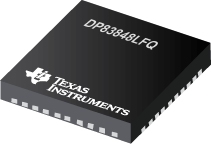PDF, 158 Kb, File published: May 3, 2004
PDF, 249 Kb, Revision: A, File published: Apr 26, 2013
This application report describes a method for using Texas Instruments PHYTERв„ў products withouttransformer magnetics. This includes a list of recommendations for configuring transformerless systems. Adescription of a typical network configuration is provided, followed by descriptions of non-typicaltransformerless configurations. Finally, this application note presents PHYTER product pe
PDF, 178 Kb, Revision: B, File published: Apr 26, 2013
This is an informational document detailing points to be considered when updating an existing 10/100Mb/s Ethernet design, using Texas Instruments DP83846 Ethernet Physical Layer (PHY) product, to thenew DP83848C/I/YB PHYTER product. Although the basic functions of the device are similar, differencesinclude feature set, pin functions, package and pinout, and possibly register operation. The i
PDF, 38 Kb, Revision: A, File published: Apr 26, 2013
This application report explains the concept and the operation of the Energy Detect mode of the DP83848.
PDF, 41 Kb, Revision: A, File published: Apr 26, 2013
This application report details the procedure to put the device into Power Down mode during initialization,configure the registers of the device to the desired mode, and then exit Power Down.
PDF, 168 Kb, Revision: A, File published: Apr 26, 2013
This application report summarizes how a designer can take advantage of RMII mode of the DP83848 toprovide lower cost system design.
PDF, 60 Kb, Revision: A, File published: Apr 26, 2013
This application note provides key recommendations for implementing serial communication systems that exceed IEC immunity test standards. To provide an example of highly reliable serial communications system implementation and testing, a Texas Instruments DP83640 Ethernet Physical Layer device was tested for International Electrotechnical Commission (IEC) immunity test compliance. Results from the
PDF, 262 Kb, Revision: A, File published: Apr 26, 2013
This application report discusses exposing semiconductor devices to potentially destructive Electro StaticDischarge (ESD).
PDF, 116 Kb, Revision: A, File published: Apr 26, 2013
This application report discusses the differences between the 10/100 Mb/s Ethernet Physical Layerdevices, DP8384x.
PDF, 301 Kb, Revision: B, File published: Apr 26, 2013
The purpose of this document is to define the 100Mb Transmit and Receive latencies of the TexasInstruments Semiconductor DP83848 and DP83849 Ethernet Transceiver family, and to document theircontributions for end-to-end packet transfer in both MII and RMII modes of operation.
PDF, 79 Kb, Revision: B, File published: Apr 26, 2013
System designers require accurate component power consumption specifications, for the purposes of thermal management, component selection, and power distribution planning.
PDF, 70 Kb, Revision: A, File published: Apr 26, 2013
This application report explains how Texas Instruments' PHYTER products help system designers toreduce radiated emissions in Ethernet 10/100 LAN applications.
PDF, 289 Kb, Revision: D, File published: Apr 26, 2013
This application report describes PHYTERв„ў design and layout guidelines.
PDF, 126 Kb, Revision: B, File published: Apr 26, 2013
The use of a reference clock that is less stable than those directly driven from an oscillator may be required for some applications. In addition, some customer applications may require partnering with devices that operate outside of the IEEE 802.3 standard for transmitted jitter.

